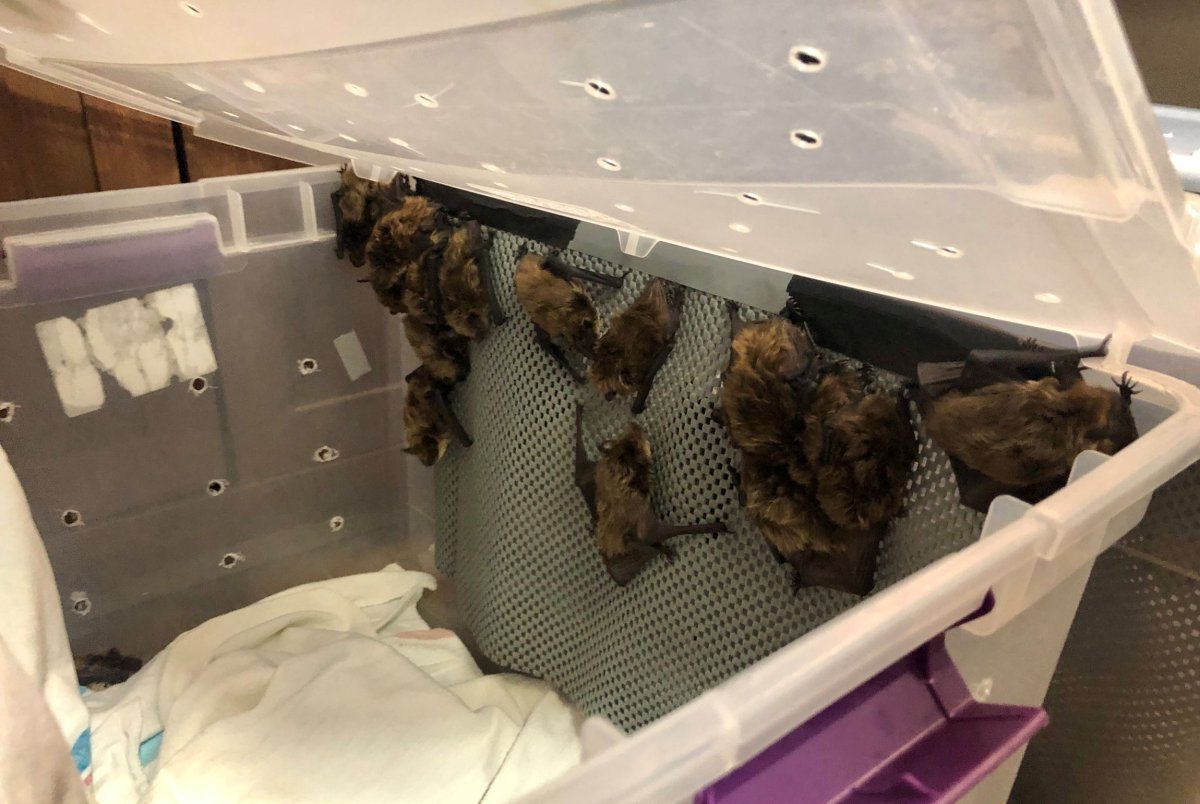A team effort is giving a colony of hibernating bats found in a Saskatchewan curling rink a temporary home and second chance.

Dave Pentecost, owner of DTS Roofing & Bat Services, said that in seven years of business, he’s never come across a colony as big as the one discovered during a renovation in Unity — and his company has still got more work to do.
“Went down there, investigated it and there was a bat infestation,” he said. “It’s (only) about a 10th of the building and we’ve probably got another 9,000 square feet to check.”
“We’re predicting maybe a couple of thousand that we end up pulling out of there.”
For Jan Shadick, executive director of Living Sky Wildlife Rehabilitation, it’s been a long week.
“We got a call from (DTS) that was hired to come in and remove the bats, and thankfully, he has a certification to do that and he does it in a very humane way,” Shadick said on Friday.
“(Pentecost) contacted us when he realized that he had the potential to have a very large colony in this very large building and so at the time, I think he said he had pulled out about 12, but there was a potential for hundreds, so we were just crossing our fingers that he had somehow miscalculated.
- What is a halal mortgage? How interest-free home financing works in Canada
- Ontario doctors offer solutions to help address shortage of family physicians
- Capital gains changes are ‘really fair,’ Freeland says, as doctors cry foul
- Budget 2024 failed to spark ‘political reboot’ for Liberals, polling suggests
“We lost about 63 that arrived, that didn’t make it (because of transport stress and crowded conditions) but there were 323 that did make it.”
Shadick said the shelter received a large number of pigeons last year but it didn’t prepare the Saskatoon charity for what it received on Feb. 5.
“Over the summer, we got in a batch of, like, 40 pigeons because somebody sold off their grain bin,” Shadick said. “I was anxious about that and … trying to figure out how we were going to do that.”
“This is a brand new experience as far as I’m aware in Saskatchewan. I mean, maybe elsewhere in the country, but I’ve certainly never heard of it. It’s mildly insane.
“It was an incredible endeavour to process all of the bats and get them settled.”
It took eight hours with four to seven volunteers working non-stop to weigh, examine and hydrate each of the big brown bats, according to Shadick.
“We had to take it out, weigh it, do an exam on it, remove some exo-parasites if there were any, and then get some fluids into them because these little guys should be hibernating and were used to hibernating,” Shadick said.
“Besides the sort of hundreds of man-hours that we’re putting in, we’ve also increased the cost and expense of our mealworms because we have to take each bat out and feed it 20 to 30 mealworms every day. So it’s been an enormous drain on our winter system, which is pretty thin to begin with.
“Bats are a rabies vector species and so I will just confirm that all of the people that handled them are part of our volunteer system who have pre-exposure rabies shots.”
Most of the bats were able to go straight back into hibernation in tubs while about 75 were held back from hibernation due to being thin or injured.
“There were about 75 that were underweight that couldn’t go directly back into hibernation and so we have been feeding them … so then as they’re gaining enough weight to be fat enough to go into hibernation,” Shadick said.
“They have to be between 5 and 15 C and so somebody with a cold cellar is perfect. We don’t have that at the facility. … And I’m really glad that we have a volunteer who is able to keep her basement at 10 C and so we were able to actually put them in her basement.”
Shadick said the plan is to later transfer the animals into a hibernation box and take them back to Unity.
“Because they’re not going to be able to go back to where they had been hibernating, we are going to have to give them a wintering hibernation box,” Shadick said.
“It has insulation and that kind of thing that they can crawl into so that when it’s warmer, they can come out and when it’s colder, they can move into the insulation. … Ideally, what will happen is we have some volunteers to make that box.
“They’ll get released when there are insects again, so hopefully April, possibly May.”
The town of Unity is approximately 195 kilometres west of Saskatoon.




Comments